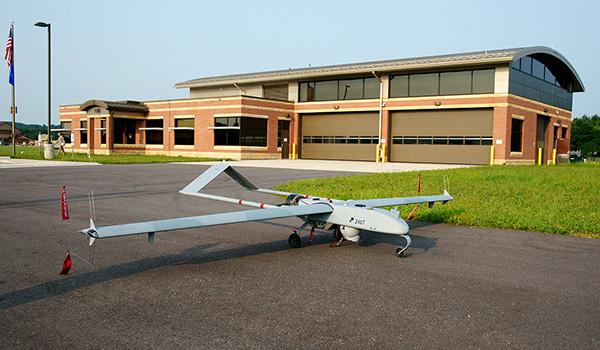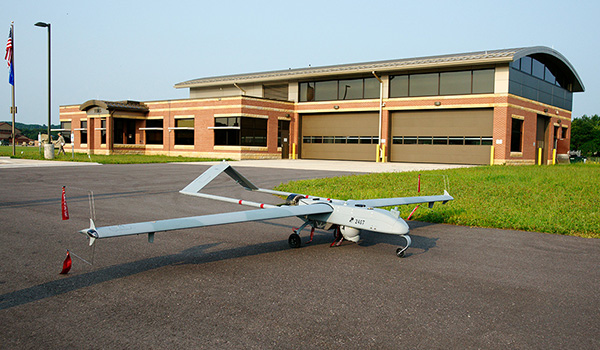
Reserve Components / By COL J. Ray Davis: Greetings again from your Army National Guard (ARNG). This month I’d like to highlight our ARNG Unmanned Aircraft Systems (UAS) capabilities, capacities, and challenges. I know that UAS isn’t this venue’s focus area until November, but I’m hoping to generate some good ideas to help attack a few of our burgeoning “areas to improve,” well before that time.

An RQ-7 Shadow Unmanned Aircraft System (UAS) in front of the Wisconsin Army National Guard Tactical UAS facility at Volk Field, Camp Douglas, WI./ WISCONSIN NATIONAL GUARD PHOTO BY CW2 LUCAS GORDON
And since – for the Guard at least – UAS falls completely outside our Aviation structures, it is indeed, the tougher nut to crack.
Currently, the ARNG has 30 Tactical UAS (TUAS) RQ-7 Shadow platoons, assigned to 28 brigade combat teams (BCTs) and 2 Special Forces Groups (SFGs). Under the Aviation Restructure Initiative (ARI), we will field zero heavy attack reconnaissance squadrons and zero Gray Eagle companies. So, Major Challenge Number 1 – no ARNG Aviation structures have or will have an organic UAS capability. This means that while the Active Component will fully develop a manned-unmanned culture within its Aviation leadership population, the Guard will be extremely challenged to do so.
To address this, our “UAS Culture” Tiger Team is conducting a DOTLM-PF (doctrine, organizations, training, leader development, materiel, personnel and facilities) analysis to generate potential solutions. These center around creating leader-development and training opportunities for ARNG Aviation leaders, such that in 5-10 years, we’ll have a robust cadre of SFCs, 1SGs, W4s, W5s, LTCs, and COLs that can competently employ UAS in combat. This is necessary, because our ARNG aviation brigades will be expected to proficiently employ Gray Eagle and Shadow (and any future UAS), once task-organized for combat. To that end, I ask all our Aviation leaders, both AC and ARNG, to seek out training and leader-development opportunities for our young(er) Aviation leaders. Be it attaching them to a brigade aviation element (BAE) for a Warfighter, having them drill with a tactical UAS (TUAS) platoon for six months, or (eventually) assigning 15Bs as BCT TUAS platoon leaders, we must be creative and dedicated to this task.
Major Challenge Number 2 is optimizing the readiness of each TUAS platoon, by maximizing the training time spent inside Restricted airspace. Ideally, all of our Shadow platoons would be able to “roll-out and launch” from their drill sites. Shy of that, we’ve got to be creative in helping that 150U platoon leader find ways to schedule concentrated periods of flying, so that our 15Ws can rapidly readiness level (RL)-progress.
The good news is that we’ve got some great Shadow platoon leaders and senior Aviation leaders who are up to the task. Our recent UAS Workshop, held in early December at the Guard’s Professional Education Center, demonstrated the dedication level and technical proficiency of our UAS community. Shadow mishaps are down, flying hour execution is up, and our leaders are focused on systemic readiness-improvement programs.
Here’s one success story: Detachment 1, Company D, 173rd Brigade Engineer Battalion (BEB), 32nd Infantry Brigade Combat Team, Wisconsin Army National Guard – WO1 Jacob Kazmierski, Platoon Leader, and CW2 Lucas Gordon, BAE UAS Operations Officer. Wisconsin has set this unit up for success: they have a beautiful new facility, located at Volk Field. They have a Certificate of Authorization to fly within this Class D airspace for “roll out and launch” operations, and they conduct about 80% of their flight operations here. For more tactical operations, they drive 24 miles to Fort McCoy and R-6901A. Aside from well-positioned facilities, they’ve invested in trainers as well, with seven instructor-operators on-hand. The results are self-evident: 14 of 16 15Ws are RL-1, and the platoon flew 624 hours of live flight in FY15. They are truly ready and available for deployment worldwide.
Finally, I’d like to bid a public semi-farewell to our deputy division chief, COL (Ret.) Bob Godwin. As most of you know, Bob is an institution here at the Readiness Center and the AAAA Washington-Potomac Chapter, and the source of all ARNG Aviation continuity and expertise. He’ll be leaving shortly. But the good news is that he’s just moving downstairs, to assume the new civilian position of Deputy G3. While he’ll no longer be dedicated to Aviation, he’ll still be close by and in our corner.
Happy February!
Fly Safe – Fly Guard (either from the cockpit, or a ground control station).
COL J. Ray Davis is the chief of the Army National Guard Aviation and Safety Division located in Arlington, VA.








